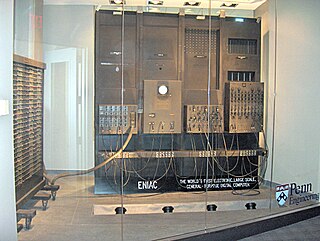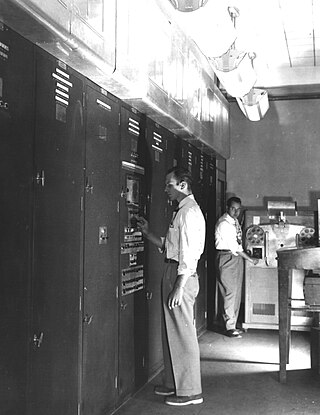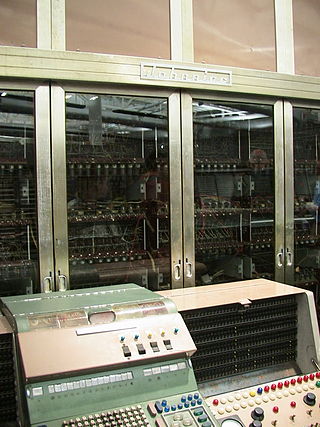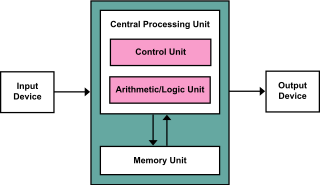

The ILLIAC I (Illinois Automatic Computer), a pioneering computer in the ILLIAC series of computers built in 1952 by the University of Illinois, was the first computer built and owned entirely by a United States educational institution.


The ILLIAC I (Illinois Automatic Computer), a pioneering computer in the ILLIAC series of computers built in 1952 by the University of Illinois, was the first computer built and owned entirely by a United States educational institution.
The project was the brainchild of Ralph Meagher and Abraham H. Taub, who both were associated with Princeton's Institute for Advanced Study before coming to the University of Illinois. The ILLIAC I became operational on September 1, 1952. [1] [2] It was the second of two identical computers, the first of which was ORDVAC, also built at the University of Illinois. These two machines were the first pair of machines to run the same instruction set.
ILLIAC I was based on the IAS machine Von Neumann architecture as described by mathematician John von Neumann in his influential First Draft of a Report on the EDVAC . Unlike most computers of its era, the ILLIAC I and ORDVAC computers were twin copies of the same design, with software compatibility. The computer had 2,800 vacuum tubes, measured 10 ft (3 m) by 2 ft (0.6 m) by 8½ ft (2.6 m) (L×B×H), and weighed 4,000 pounds (2.0 short tons; 1.8 t). [3] ILLIAC I was very powerful for its time; in 1956, it had more computing power than all of Bell Telephone Laboratories.
Because the lifetime of the tubes within ILLIAC was about a year, the machine was shut down every day for "preventive maintenance" when older vacuum tubes would be replaced in order to increase reliability. Visiting scholars from Japan assisted in the design of the ILLIAC series of computers, and later developed the MUSASINO-1 computer in Japan. ILLIAC I was retired in 1962, when the ILLIAC II became operational.

ENIAC was the first programmable, electronic, general-purpose digital computer, completed in 1945. There were other computers that had combinations of these features, but the ENIAC had all of them in one package. It was Turing-complete and able to solve "a large class of numerical problems" through reprogramming.

EDVAC was one of the earliest electronic computers. It was built by Moore School of Electrical Engineering, Pennsylvania. Along with ORDVAC, it was a successor to the ENIAC. Unlike ENIAC, it was binary rather than decimal, and was designed to be a stored-program computer.

The JOHNNIAC was an early computer built by the RAND Corporation and based on the von Neumann architecture that had been pioneered on the IAS machine. It was named in honor of von Neumann, short for John von NeumannNumerical Integrator and Automatic Computer. JOHNNIAC is arguably the longest operational early computer, being used almost continuously from 1953 for over 13 years before finally being shut down on February 11, 1966, logging over 50,000 operating hours.

The IAS machine was the first electronic computer built at the Institute for Advanced Study (IAS) in Princeton, New Jersey. It is sometimes called the von Neumann machine, since the paper describing its design was edited by John von Neumann, a mathematics professor at both Princeton University and IAS. The computer was built from late 1945 until 1951 under his direction. The general organization is called von Neumann architecture, even though it was both conceived and implemented by others. The computer is in the collection of the Smithsonian National Museum of American History but is not currently on display.

The ORDVAC, is an early computer built by the University of Illinois for the Ballistic Research Laboratory at Aberdeen Proving Ground. A successor to the ENIAC. It was based on the IAS architecture developed by John von Neumann, which came to be known as the von Neumann architecture. The ORDVAC was the first computer to have a compiler. ORDVAC passed its acceptance tests on March 6, 1952, at Aberdeen Proving Ground in Maryland. Its purpose was to perform ballistic trajectory calculations for the US Military. In 1992, the Ballistic Research Laboratory became a part of the U.S. Army Research Laboratory.
The Cyclone, was a vacuum tube computer, built by Iowa State College at Ames, Iowa. The computer was commissioned in July 1959. It was based on the IAS architecture developed by John von Neumann. The prototype was ILLIAC, the University of Illinois Automatic Computer. The Cyclone used 40-bit words, used two 20-bit instructions per word, and each instruction had an eight-bit op-code and a 12-bit operand or address field. In general IAS-based computers were not code compatible with each other, although originally math routines which ran on the ILLIAC would also run on the Cyclone.

The MANIAC I was an early computer built under the direction of Nicholas Metropolis at the Los Alamos Scientific Laboratory. It was based on the von Neumann architecture of the IAS, developed by John von Neumann. As with all computers of its era, it was a one-of-a-kind machine that could not exchange programs with other computers. Metropolis chose the name MANIAC in the hope of stopping the rash of silly acronyms for machine names, although von Neumann may have suggested the name to him.

The SILLIAC, an early computer built by the University of Sydney, Australia, was based on the ILLIAC and ORDVAC computers developed at the University of Illinois.

The von Neumann architecture — also known as the von Neumann model or Princeton architecture — is a computer architecture based on a 1945 description by John von Neumann, and by others, in the First Draft of a Report on the EDVAC. The document describes a design architecture for an electronic digital computer with these components:

Herman Heine Goldstine was a mathematician and computer scientist, who worked as the director of the IAS machine at Princeton University's Institute for Advanced Study and helped to develop ENIAC, the first of the modern electronic digital computers. He subsequently worked for many years at IBM as an IBM Fellow, the company's most prestigious technical position.
The ORACLE or Oak Ridge Automatic Computer and Logical Engine, an early computer built by Oak Ridge National Laboratory, was based on the IAS architecture developed by John von Neumann.
The First Draft of a Report on the EDVAC is an incomplete 101-page document written by John von Neumann and distributed on June 30, 1945 by Herman Goldstine, security officer on the classified ENIAC project. It contains the first published description of the logical design of a computer using the stored-program concept, which has come to be known as the von Neumann architecture; the name has become controversial due to von Neumann's failure to name other contributors.
ILLIAC was a series of supercomputers built at a variety of locations, some at the University of Illinois at Urbana–Champaign. In all, five computers were built in this series between 1951 and 1974. Some more modern projects also use the name.

Donald Bruce Gillies was a Canadian computer scientist and mathematician who worked in the fields of computer design, game theory, and minicomputer programming environments.
The MUSASINO-1 was one of the earliest electronic digital computers built in Japan. Construction started at the Electrical Communication Laboratories of NTT at Musashino, Tokyo in 1952 and was completed in July 1957. The computer was used until July 1962. Saburo Muroga, a University of Illinois visiting scholar and member of the ILLIAC I team, returned to Japan and oversaw the construction of MUSASINO-1.

Abraham Haskel Taub was a distinguished American mathematician and physicist, well known for his important contributions to the early development of general relativity, as well as differential geometry and differential equations.
Minimal instruction set computer (MISC) is a central processing unit (CPU) architecture, usually in the form of a microprocessor, with a very small number of basic operations and corresponding opcodes, together forming an instruction set. Such sets are commonly stack-based rather than register-based to reduce the size of operand specifiers.

The MISTIC, or Michigan State Integral Computer, was the first computer system at Michigan State University and was built by its students, faculty and staff in 1957. Powered by vacuum tubes, its design was based on ILLIAC, the supercomputer built at University of Illinois at Urbana–Champaign, a descendant of the IAS architecture developed by John von Neumann.

The University of Illinois Department of Computer Science is the academic department encompassing the discipline of computer science at the University of Illinois at Urbana-Champaign. According to U.S. News & World Report, both its undergraduate and graduate programs rank in the top five among American universities. The department ranks equally high in faculty submissions to reputable journals and academic conferences, as determined by CSRankings.org. According to Computer Science Open Rankings, the department ranks equally high in placing Ph.D. students in tenure-track positions at top universities and winning best paper awards. From before its official founding in 1964 to today, the department's faculty members and alumni have contributed to projects including the ORDVAC, PLATO, Mosaic, JavaScript and LLVM, and have founded companies including Siebel Systems, Netscape, Mozilla, PayPal, Yelp, YouTube, and Malwarebytes.

A vacuum-tube computer, now termed a first-generation computer, is a computer that uses vacuum tubes for logic circuitry. Although superseded by second-generation transistorized computers, vacuum-tube computers continued to be built into the 1960s. These computers were mostly one-of-a-kind designs.